The Art of Resurrecting Heirloom Watermelons
Some of the country’s best-tasting watermelons are the ones you’ve never heard of. These people are distributing their seeds— preserving their history and securing their future.
The Art of Resurrecting Heirloom Watermelons
Some of the country’s best-tasting watermelons are the ones you’ve never heard of. These people are distributing their seeds— preserving their history and securing their future.
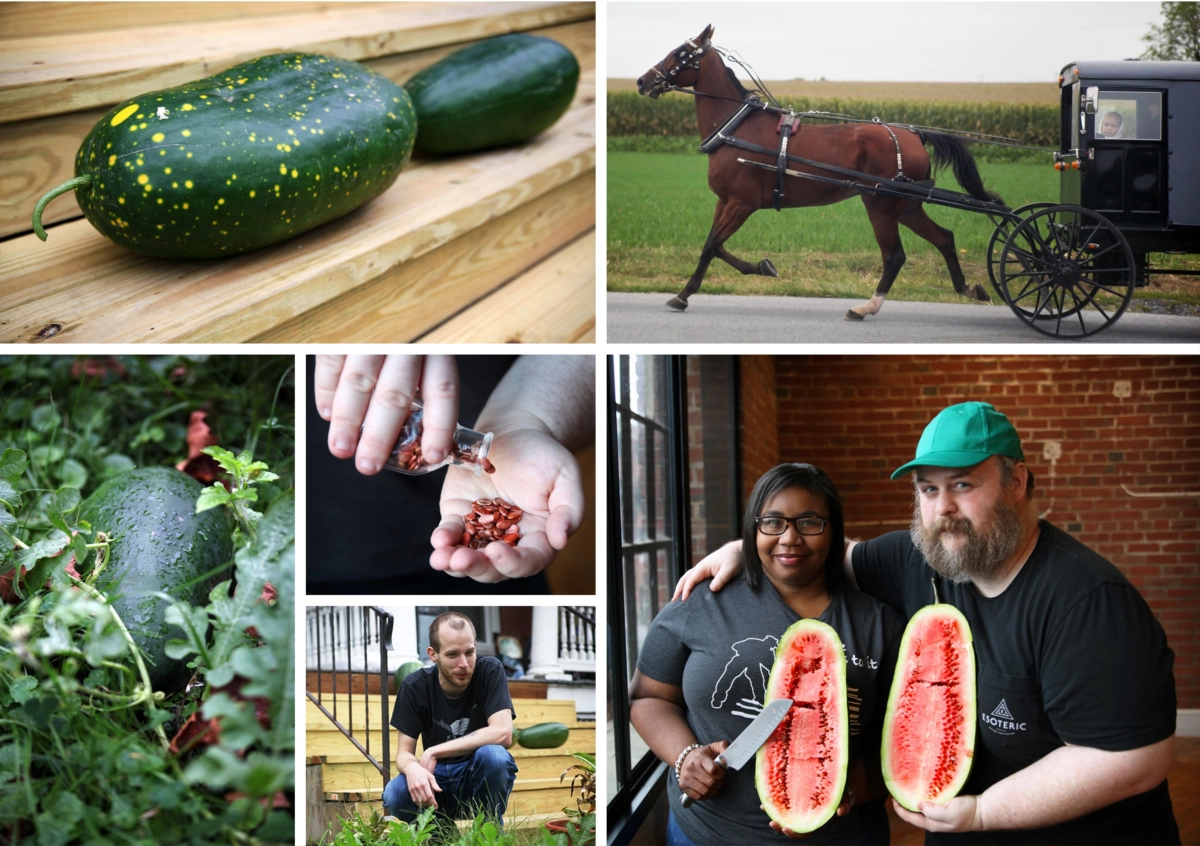
Freeman and Fitzwater have driven thousands of miles in pursuit of rare watermelons.by Joshua Fitzwater
It was hot in Louisiana, and after 15 hours in the car to get there from Virginia, Joshua Fitzwater and Debra Freeman stepped into the humidity that is common in the community of Calhoun.
They had come all that way to track down a watermelon that few people had heard about and even fewer have actually tasted. The Red-N-Sweet was the last watermelon produced by the Calhoun Research Station in 1987. The station shuttered permanently in 2011, and many seeds were lost—potentially forever. Kerry Heafner, a Louisiana State University associate extension agent in horticulture, had been able to track down a few of them, like the Red-N-Sweet. This melon is a deep, dark red, and it’s incredibly sweet.
“The minute I tasted that watermelon I was like, holy crap, this is the best-tasting heirloom I’ve ever had,” says Fitzwater.
In 2019, Fitzwater and Freeman would drive thousands of miles on a quest to find the rarest, most interesting watermelons that no longer exist in the greater commercial market. Along the way, they tasted and photographed melons, harvesting the seeds to save and plant. Fitzwater and Freeman, both professional storytellers, also diligently collected the history and context surrounding each type of seed they came across.
“You’re touching that history, and in a way, preserving that history by saving these rare heirloom watermelons,” says Fitzwater.
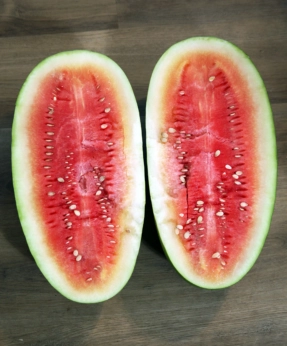
As the founder of Southern Grit magazine, Fitzwater was in a unique position to facilitate this kind of project. He had extensive contacts in both the farming and culinary industries across the region. This made it easier to distribute seeds into the hands of willing growers and to connect heirloom watermelons with creative chefs, brewers and bartenders. In doing so, they are helping to pull these rare melons back from the edge of oblivion and onto people’s plates.
“As we lose these, we lose taste and we lose history,” says Fitzwater. “It’s a double loss.”
‘Bit by the watermelon bug’
To date, Fitzwater has tasted upwards of 40 heirloom watermelons, but his interest in rare varietals began more generally. Fitzwater started Southern Grit in 2014, and began diving deep into the history of certain heirloom crops specific to the region such as Silver Queen corn and Hanover tomatoes. But it was the watermelon that grabbed him and wouldn’t let go. It started when he came across the Moon and Stars watermelon and was shocked to find that the insides were not red but orange.
“I was kind of struck by it,” says Fitzwater. “I think that was the point when I was bit by the watermelon bug, so to speak.”
Meanwhile, Freeman, who is a writer, food anthropologist and the creator and host of the Setting the Table podcast, which explores Black foodways, had been reading up about the Bradford watermelon. It’s a special heirloom grown by the Bradford family out in Sumter, South Carolina. The pair decided they would make a road trip out there to try it in 2019. This road trip was one of many that year.
“We’re driving up and down the Eastern Seaboard, basically every weekend, trying to hunt these things down,” says Freeman.
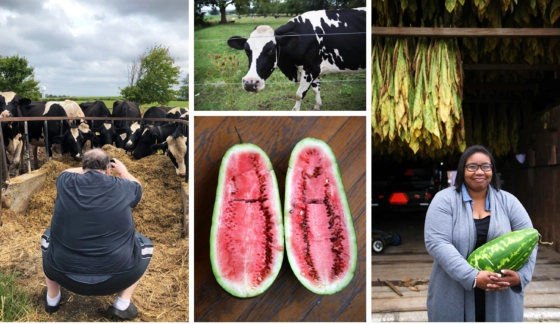
Two years later, their travels took them down to Louisiana. Fitzwater had heard of Heafner online, because Heafner was on something of a quest himself. He was collecting heirloom seeds of all kinds from across Louisiana.
For Heafner, his connection with the Red-N-Sweet started when he gave a talk to the Marion Garden Club in northern Louisiana.
“A lady approached me and said, ‘I have something you might be interested in,’” says Heafner. The woman, Lula Shurtleff, told him she had some watermelon seeds that she suspected were from the Calhoun Research Station. She’d been keeping them in her freezer for years.
Heafner accepted the seeds, germinated and grew them, and that’s how the Red-N-Sweet watermelon resurfaced. Heafner now runs the North Louisiana Seed Preservation Program with his colleague Marcie Wilson, and he says that he commonly gets contacted by people who have saved seeds or have been growing a unique variety of something in their families for generations, including apples, peas, eggplants and more. The goal of this project is to make these nearly lost seeds available to growers again.

“You just never know what someone has tucked away in their freezer,” says Heafner.
Collecting and saving these seeds is not just a way to preserve genetic diversity but also the agricultural and culinary history of the region, says Heafner. Many of the widely available commercial watermelons today are bred for traits that make them able to withstand cross-country transport.
Tasting an heirloom melon means re-establishing the connection with the grower, which Freeman says has largely been lost from American culture. The Red-N-Sweet, for example, is now back in the hands of some small growers in Louisiana and beyond.
“It obviously creates a sense of place for them,” says Freeman. “I think it gives them a deeper connection to where they live.”
Tony’s watermelons
To actually grow the watermelons, Fitzwater enlisted the help of his dad. As it turns out, Anthony “Tony” Fitzwater has quite the knack for growing watermelons.
According to Joshua Fitzwater, his dad is successfully growing some of the rarest watermelons in the country. And these heirloom watermelons can be “skittish.” They take a lot of careful monitoring and care to keep them on track.
That first growing year, he and his dad were out in the patch several times per week, says Fitzwater. “I had to drive like an hour every day to get there—he had to drive even further.”
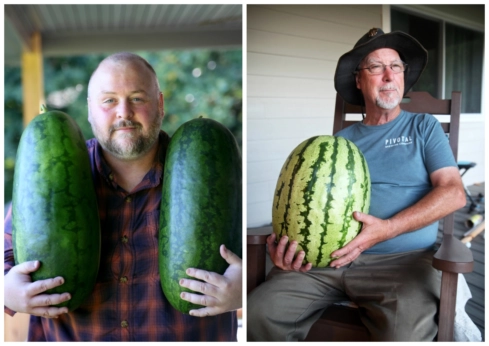
Most days in the patch, the father and son worked in heat over 90 degrees, learning what worked best.
“I think it has brought them closer together because that’s something that they were working on in tandem,” says Freeman.
The hard work paid off—Tony led the way to harvest after harvest. Now, thanks to Shurtleff, Heafner, Freeman and the Fizwaters, the Red-N-Sweet, which had all but disappeared, is being cultivated by small growers in California, Virginia, Louisiana and beyond. Fitzwater estimates that they’ve put the seeds of the Red-N-Sweet into the hands of 1,000 growers across the country. They repeated this process with the Florida Favorite, a watermelon that had disappeared from the commercial market. After getting 10 seeds from the USDA, the Fitzwaters were able to germinate six and grow them in the summer of 2023. This year, they’ll be able to reintroduce the seeds from their harvest to the public.
Around Halifax County, people start to recognize Tony as the watermelon man, says Fitzwater.
“None of this would have been possible without Kerry Heafner, without the farmers in Louisiana and without my dad.”
Watermelon on the rocks
In addition to getting heirloom seeds into the hands of growers, Fitzwater has also been getting melons into the public eye by connecting with the local culinary scene. Josh Seaburg is a bartender in Virginia who has helped build and execute multiple cocktail programs in the area. When he heard about Fitzwater’s heirloom watermelons, it was too good of an opportunity to pass up. Seaburg reached out to let Fitzwater know he would be interested in incorporating these melons into a cocktail menu. The first heirloom that Fitzwater brought Seaburg to try was the Bradford.
“I remember just being absolutely flabbergasted with how much different it was than a grocery store melon,” says Seaburg. “[I] became kind of obsessed with the flavor of it.”
One of the watermelons Seaburg received was the Red-N-Sweet, and for the restaurant Crudo Nudo in Norfolk, he created a pale pink, carbonated, bottled cocktail out of it by juicing the melon, adding sugar and acid and mixing it with Singani, a Bolivian spirit.
There’s a novelty in getting to work with such a unique food item, says Seaburg. “I also appreciate the trust that Fitz has in the partnership, knowing that these rare melons are in safe hands and going to be turned into something interesting and delicious.”
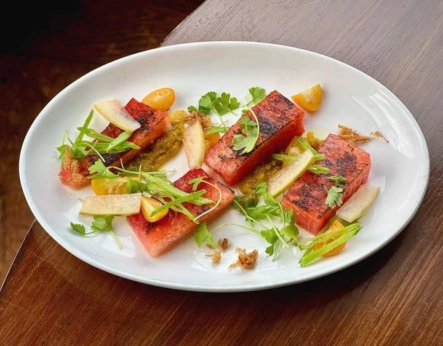
More than a melon
Food is a natural connector, says Freeman. And when you tell the story of a watermelon, it’s not really about the melon itself but the people who created and cultivated it.
“I just think it’s so special to learn these stories and the people connected to them because every single one of these watermelons was grown for a specific reason,” says Freeman.
It’s not just about taste, says Fitzwater, but also the history. Take Odell’s White Watermelon, which was developed in South Carolina by an enslaved man named Harry. It was named after a subsequent grower, not the man who actually bred it. This large melon with rose-colored flesh and pale green skin is cataloged in the Slow Food Ark of Taste, an organization that helps bring attention to distinctive and endangered foods. Today, the seeds are sold by companies such as Truelove Seeds and Sistah Seeds.
“How do you talk about watermelons without talking about Africa?” says Fitzwater. “How do you talk about watermelons without talking about the plethora of enslaved growers that were involved in this process?”
Both Fitzwater and Freeman have written about the context behind some of these watermelons.
“When you cut into a watermelon, it’s so much more than cutting into a watermelon,” says Fitzwater. “You’re cutting into someone’s labor, someone’s mind, someone’s past mistakes. And then finally they got it right. It’s just so much more connected to life.”
What started out as a quirky, personal project for the Fitzwaters and Freeman led to something much bigger—restoring public access to rare watermelons. Despite the grand arc that this project has taken, Freeman also points out that this is something anyone can do. With a little bit of legwork, anyone can track down something and connect with it themselves.
“I think they will find an emotional connection that they didn’t expect,” says Freeman.
The Fitzwaters have had five plantings since they began this adventure in 2019, and they plan to continue this work—growing melons, dispersing seeds, infusing them into the culinary scene, and of course, chasing down the next elusive watermelon. Next stop: Alabama in search of the Duke Jones watermelon. If Joshua can find it, he’ll bring it back and he and Tony will plant it out next summer.
“I’ve seen rumblings of it online,” says Fitzwater. “But it’s not commercially available.”
Follow us

This work is licensed under a Creative Commons Attribution-NoDerivatives 4.0 International License.
Want to republish a Modern Farmer story?
We are happy for Modern Farmer stories to be shared, and encourage you to republish our articles for your audience. When doing so, we ask that you follow these guidelines:
Please credit us and our writers
For the author byline, please use “Author Name, Modern Farmer.” At the top of our stories, if on the web, please include this text and link: “This story was originally published by Modern Farmer.”
Please make sure to include a link back to either our home page or the article URL.
At the bottom of the story, please include the following text:
“Modern Farmer is a nonprofit initiative dedicated to raising awareness and catalyzing action at the intersection of food, agriculture, and society. Read more at <link>Modern Farmer</link>.”
Use our widget
We’d like to be able to track our stories, so we ask that if you republish our content, you do so using our widget (located on the left hand side of the article). The HTML code has a built-in tracker that tells us the data and domain where the story was published, as well as view counts.
Check the image requirements
It’s your responsibility to confirm you're licensed to republish images in our articles. Some images, such as those from commercial providers, don't allow their images to be republished without permission or payment. Copyright terms are generally listed in the image caption and attribution. You are welcome to omit our images or substitute with your own. Charts and interactive graphics follow the same rules.
Don’t change too much. Or, ask us first.
Articles must be republished in their entirety. It’s okay to change references to time (“today” to “yesterday”) or location (“Iowa City, IA” to “here”). But please keep everything else the same.
If you feel strongly that a more material edit needs to be made, get in touch with us at [email protected]. We’re happy to discuss it with the original author, but we must have prior approval for changes before publication.
Special cases
Extracts. You may run the first few lines or paragraphs of the article and then say: “Read the full article at Modern Farmer” with a link back to the original article.
Quotes. You may quote authors provided you include a link back to the article URL.
Translations. These require writer approval. To inquire about translation of a Modern Farmer article, contact us at [email protected]
Signed consent / copyright release forms. These are not required, provided you are following these guidelines.
Print. Articles can be republished in print under these same rules, with the exception that you do not need to include the links.
Tag us
When sharing the story on social media, please tag us using the following: - Twitter (@ModFarm) - Facebook (@ModernFarmerMedia) - Instagram (@modfarm)
Use our content respectfully
Modern Farmer is a nonprofit and as such we share our content for free and in good faith in order to reach new audiences. Respectfully,
No selling ads against our stories. It’s okay to put our stories on pages with ads.
Don’t republish our material wholesale, or automatically; you need to select stories to be republished individually.
You have no rights to sell, license, syndicate, or otherwise represent yourself as the authorized owner of our material to any third parties. This means that you cannot actively publish or submit our work for syndication to third party platforms or apps like Apple News or Google News. We understand that publishers cannot fully control when certain third parties automatically summarize or crawl content from publishers’ own sites.
Keep in touch
We want to hear from you if you love Modern Farmer content, have a collaboration idea, or anything else to share. As a nonprofit outlet, we work in service of our community and are always open to comments, feedback, and ideas. Contact us at [email protected].by Lena Beck, Modern Farmer
October 18, 2023
Modern Farmer Weekly
Solutions Hub
Innovations, ideas and inspiration. Actionable solutions for a resilient food system.
ExploreExplore other topics
Share With Us
We want to hear from Modern Farmer readers who have thoughtful commentary, actionable solutions, or helpful ideas to share.
SubmitNecessary cookies are absolutely essential for the website to function properly. This category only includes cookies that ensures basic functionalities and security features of the website. These cookies do not store any personal information.
Any cookies that may not be particularly necessary for the website to function and are used specifically to collect user personal data via analytics, ads, other embedded contents are termed as non-necessary cookies.
I like what you are doing. I live in Puerto Rico. In a seed trading group. That’s how I have gotten a lot of varieties of veggies. I didn’t even new they exist. Here in Puerto Rico 80 % of the food in the supermarket is imported. I’m trying to get people to realize that we need to start planting our own crops. An increase that 20 to 80 if not more. I’m planting here any fruit or veggie that will grow in temps from 60f and above. I have managed to grow successfully Mung beans Tankuro Soy Beans Edamame… Read more »
This article really resonated with me. Highlighting the stories behind these rare watermelons adds so much depth to their existence. It’s not just fruit, it’s a legacy, a testament to resilience and forgotten contributions.
This blew my mind! I never thought about watermelons having such depth and history behind them. It’s so easy to just grab one at the grocery store and think of it as a summer treat, but this article really opened my eyes. Learning about the stories of the people who created and cultivated these varieties, especially the Odell’s White Watermelon developed by an enslaved man, adds a whole new layer of meaning to enjoying this fruit.
Seaburg’s creativity really shines here. Turning the heirloom watermelon into a pale pink, bubbly cocktail sounds incredible! It highlights the special qualities of these melons and adds a whole new level of intrigue to the drink.